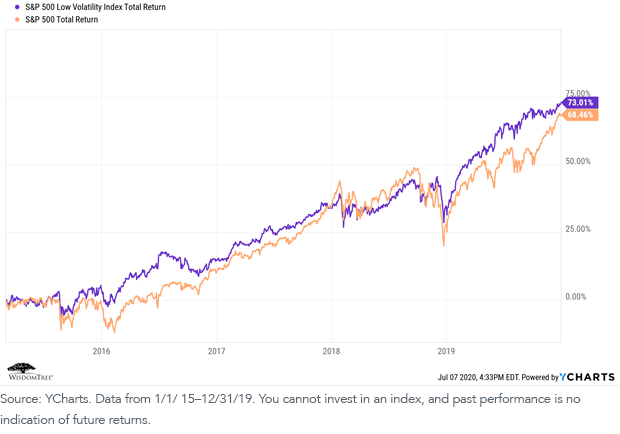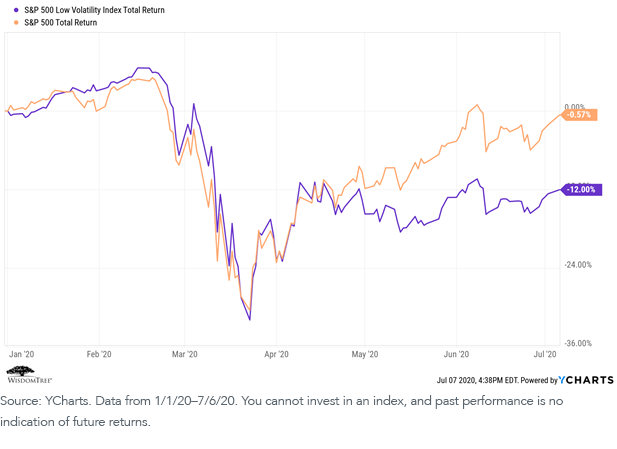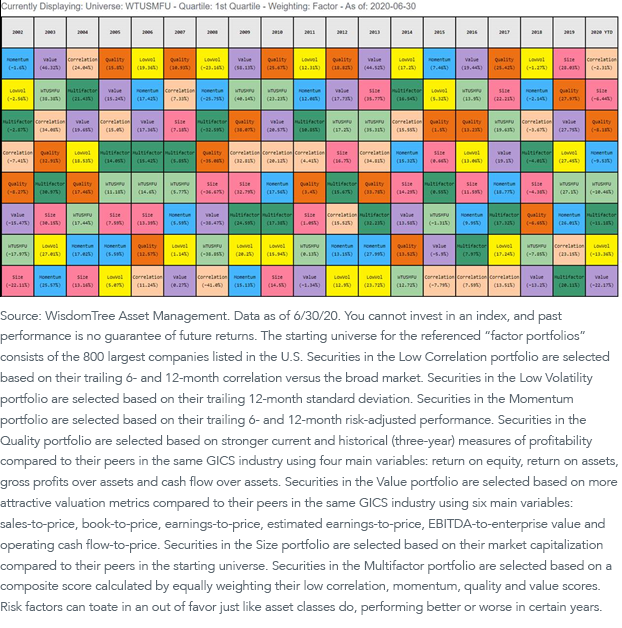Desperately Seeking Low Volatility


This article is relevant to financial professionals who are considering offering model portfolios to their clients. If you are an individual investor interested in WisdomTree ETF Model Portfolios, please inquire with your financial professional. Not all financial professionals have access to these model portfolios.
All my friends know the low rider
The low rider is a little higher
Low rider drives a little slower
Low rider is a real goer
Low rider knows every street, yeah
Low rider is the one to meet, yeah
Low rider don’t use no gas now
Low rider don’t drive too fast
Take a little trip, take a little trip
Take a little trip and see
Take a little trip, take a little trip
Take a little trip with me
(From “Low Rider (On the Boulevard),” performed by War, 1975)
One of the more popular investment risk factors over the past 3–5 years has been “low volatility.” Classic investment theory suggests that stocks with lower volatility should also have a lower expected return, but for the past five years up until the end of 2019, that simply was not the case:

For definitions of indexes in the chart, please visit our glossary.
That outperformance, however, has broken down in 2020, no doubt influenced by the virus-induced market disruptions:

As we have written about before, risk factors rotate in an out of favor just like asset classes do, and “low vol” is no exception (it is the bright yellow box in the “performance quilt” below):

Another characteristic of “low vol” investing is that its recent popularity with investors has driven the valuations of “low vol” stocks sky-high. The current P/E ratio of a popular S&P 500 “low vol” ETF is trading at only a slight discount to the P/E ratio of the mainstream S&P 500 Index ETF itself. And remember that the mainstream ETF includes what we view to be hyper-valued large-cap tech stocks. For now, dividends for the sector appear safe to us, providing a key level of near-term valuation support. But, nonetheless, “low vol” investing has become expensive.
Put differently, investors seem willing to “pay up” for a low-volatility allocation within their portfolio, but, as we know, the future potential performance of any investment is a function of how much you pay for it today. If you pay a high multiple today, your future potential performance typically is reduced.
We have written before about the inclusion of lower-correlated strategies into portfolios as a way of improving overall diversification, and we make those strategies explicitly available in our Endowment Model and our Volatility Management Model.
But there is another way to lower portfolio volatility without overpaying for “low vol” stocks. As a part of our Outcome-Focused Model Portfolio sleeves, we offer three versions of a “smart beta” or “multifactor” model portfolio—one each for the U.S., developed international and emerging markets. All these portfolios are designed specifically to deliver a high level of risk factor diversification, thereby potentially lowering the overall volatility of a broader portfolio.
Each of these models could be used as a stand-alone equity portfolio—they are geographically specific in nature, but within each region they are diversified across asset classes, styles and risk factors. But each of them (or a combination of them) can also act as a complement to an existing equity portfolio for advisors seeking to reduce volatility without having to make wholesale reallocations.
Currently, each of these the multifactor models has explicit allocations to a variety of risk factors, including:
As with all WisdomTree Model Portfolios, these models are “open architecture” (that is, they include both proprietary and third-party products), and they carry no strategist fee.
The inclusion of one or more of these models into an overall portfolio can help achieve a similar outcome to allocating to “low vol” stocks, but at much more attractive valuation levels.
For some perspective, consider the performance of the dark green “Multifactor” box in the risk factor performance quilt above. That box does not reflect the actual performances of the model portfolios—those boxes reflect index-level performances, and you cannot invest in an index, nor is past performance any guarantee of future results.
But you can get a sense of the historical improved performance consistency by incorporating multiple factors into a portfolio (that is, the green boxes tend to cluster around the middle of the performance quilt).
Just like with asset classes, when certain parts of the market are rallying strongly (e.g., large-cap tech), a more diversified portfolio will generally not keep up with that sector or risk factor.
But we believe we may have entered a new market regime, driven by both the ongoing pandemic and corresponding governmental intervention, that will be characterized by increased volatility.
For advisors seeking to improve the risk factor diversification of their overall portfolio and thereby potentially lowering portfolio volatility—but without “paying up” for “low volatility” securities—the WisdomTree multifactor models may be worth looking into.
Important Risks Related to this Article
There are risks associated with investing, including the possible loss of principal. Diversification does not eliminate the risk of experiencing investment losses. Using an asset allocation strategy does not ensure a profit or protect against loss.
This material does not constitute any specific legal, tax or accounting advice. Please consult with qualified professionals for this type of advice. This material is not intended to be a recommendation or advice by WisdomTree. WisdomTree does not undertake to provide impartial investment advice or give advice in a fiduciary capacity. Further, WisdomTree receives revenue in the form of advisory fees for our exchange-traded funds, and WisdomTree is also entitled to receive a fee from certain model platform providers for licensing model portfolios.
WisdomTree Asset Management, Inc., is an investment advisor registered with the Securities Exchange Commission and a wholly owned subsidiary of WisdomTree Investments, Inc.
For financial professionals: In the event that you subscribe to receive a WisdomTree Model Portfolio, you will receive investment ideas from WisdomTree in the form of a model portfolio. The information is designed to be utilized by you solely as a resource, along with other potential sources you consider, in providing advisory services to your clients. WisdomTree’s Model Portfolios are not intended to constitute investment advice or investment recommendations from WisdomTree. WisdomTree is not responsible for determining the securities to be purchased, held and/or sold for your clients’ accounts, nor is WisdomTree responsible for determining the suitability or appropriateness of a model portfolio or any securities included therein for any of your clients. WisdomTree does not have investment discretion and does not place trade orders for any of your clients’ accounts. Information and other marketing materials provided to you by WisdomTree concerning a model portfolio—including holdings, performance and other characteristics—may not be indicative of your client’s actual experience from investing in one or more of the funds included in the model portfolio. The model portfolios, allocations and data are subject to change.
For end users: WisdomTree’s Model Portfolios are not intended to constitute investment advice or investment recommendations from WisdomTree. Your investment advisor may or may not implement WisdomTree’s Model Portfolios in your account. WisdomTree is not responsible for determining the suitability or appropriateness of a strategy based on WisdomTree’s Model Portfolios. WisdomTree does not have investment discretion and does not place trade orders for your account. This material has been created by WisdomTree, and the information included herein has not been verified by your investment advisor and may differ from information provided by your investment advisor. The model portfolios, allocations and data are subject to change.


